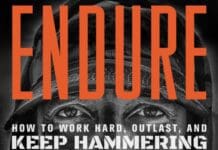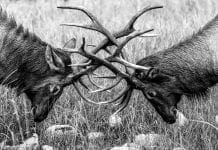Training Tips for Hunting the West
by Les Welch
Every year right after New Year, the gym comes alive with people vowing to lose weight, pack on muscle, and change their lives. Usually within the next month they dwindle off and the gym returns to normal. For most of us serious backcountry hunters, our seasons are just ending. Now is the time to evaluate how good our pre-season conditioning was.
 Many times surfing some of the popular internet hunting sites I see guys talking about starting to get into hunting shape. This could be in June, maybe July, and yes even in August, whoa really? Coming from the East side of the
Many times surfing some of the popular internet hunting sites I see guys talking about starting to get into hunting shape. This could be in June, maybe July, and yes even in August, whoa really? Coming from the East side of the
For those of us who live about a snail’s hair above sea-level, year around training is key. We don’t have the ability to head out to the mountains for week-end scouting, hiking, or training. So now the question becomes what can we do to get into “elk shape”?
Let’s define what I call “elk shape”. To me, this means being able to hike in 6-10 miles with a 65-95# pack on your back, with every thing you need for a couple weeks of wilderness high country adventure. Ok, so you are in and camp is set, nothing but fun left now right? Hardly, now the work begins. Leaving camp before daylight, hunting all day, and returning after dark day after day takes its toll physically and mentally. Animal down, now you need to be able to pack out 300# of meat, 8 miles one way. Are you ready?
I know guys who spend time training on an elliptical machine or running on a treadmill. Granted these things are going to burn calories, and increase your aerobic capacity, but is that really what you need on a wilderness backpack hunt at 10,000+ feet?
To do what I have described above, I stick to a year around training regimen. To be at the top of the food chain a 2-3 month workout session doesn’t cut it. Physically you need strong legs, back, and core muscles. In the upcoming paragraphs I’ll outline what works for me. I’ll list a few gym and home exercises. Find the variation that works for you and have better health and more success for years to come.
I’ll do 9 sets of 6-8 reps for each muscle group. With proper timing you should be in and out in less than an hour each day.
Mondays I work Chest, Back, and Calf muscles. Some of the exercises for Chest are the Incline, Decline, and Flat Bench Press. At home you could do Pushups (multiple variations), dumbbell press (multiple variations), and dips. For Back exercises we can do bent over barbell rows, seated cable rows, T-bar rows, and reverse grip bent over rows. At home you could do Kettle bell rows, dumbbell rows, and one-armed dumbbell rows. For Calves we can do Calf raises on the leg Press machine, Smith Machine Reverse Calf Raises, and Seated Calf raises. At home you can do Calf raises on a stair step, a dumbbell, against a wall, or with exercise bands.
Tuesdays I do Biceps, Triceps, and Hamstrings. For Biceps we can do standing barbell curls, lying incline bench barbell curls, and barbell preacher curls. At home we can do dumbbell curls, hammer curls, and seated concentration curls. Triceps exercises include Triceps cable pushdowns, Overhead cable extensions, and lying barbell skull crushers. At home you can do overhead barbell extensions, bench dips, and seated Triceps press. For Hamstrings at the gym I will do 50# weighted dumbbell lunges, lying hamstring curls, and donkey kicks. At home I will do lunges, bench modified donkey kicks, and squats.
Wednesday mornings I swim for 20 minutes, attend a 45 minute spin class, and then run 2-4 miles right after spinning. Then in the evenings I teach a 45 minute spin class, followed by a 5k run.
Thursdays I lift Shoulders, Quadriceps, and do abs/core work. Shoulder work can include Front/Side cable raises, front plate raises, push press, and reverse machine fly’s. Home exercises can include alternating deltoid raises, arm circles, and
Friday’s find me back in the pool, running the track, riding the bike, and on the rowing machine.
I maintain this lifting routine year around, except on my hunts….then I’m putting all those hours of training to use! Every 4 weeks I change up my lifting program. About this time my body starts to adapt to what I am doing, so I change it up and confuse things. This keeps the body working and gaining. Following this routine; my goal isn’t to become the next Arnold Schwarzenegger, its just to build and maintain a reasonable amount of muscle so that I can excel in the mountains. There is definitely a fine line on how much muscle you want to carry around at 10,000+ feet!
I really push to work out every Monday-Friday, when it comes to the week-end I usually find myself at the gym at least one day and sometimes both in the winter time. November through March can be pretty difficult to be outside in my region of
Two things I really focus on are Legs and mental toughness. If I could only pick one thing to be the strongest in the mountain, it would be mental toughness. If you are in the right mindset, you will be able to do it. Once your mind gives in, you might as well pack out, at that point you could be the best athlete in the world, but its game over. As a personal trainer every day I see and hear people say “I can’t” or “that’s it”, when really they are only 70% spent. I can get that next 20% out of them pretty easily, and usually even that next 5-10% we can find. Problem is in the backcountry there isn’t anyone holding your hand, it’s up to you to dig deep and take care of business. Win or lose its how YOU choose.
Legs. Yep they are vital in the backcountry, right behind your attitude. In the winter time I will snowshoe with my kid in a pack, or a pack full of weight. Lunges, I shudder to think how many thousands I do every year. Some plain, some plyometric, some with 50# dumbbells, or with barbells. Some days I will do 250 flights of stairs on the stair mill. Sometimes they are weighted with a pack, or dumbbells in my hands, maybe the next time it is for speed. How many can I get done in 30 minutes, or how long does it take me to get to 250 flights? This really brings the mental aspect into the game. 250 flights isn’t easy, you will want to quit. When doing the timed climbs I won’t let myself be slower than last time, I’ll puke before that happens! This is the mental drive that I talk about. During spring I shed hunt, do a lot of scouting, and food plot work, etc. I bike at least 100 miles a week, generally much more than that. Biking in a group really pushes me, great Quad and Cardio workouts. During the week I’ll run bleachers at the stadium, hike with the family in the hills with a weighted pack and if the weather is crappy just head indoors and find something. I usually run 5-8 road races per year, and do a few triathlons.
By now we are at late summer, my tags have long since arrived, my training is peaked and I’m beyond ready to hit the trails. With a couple weeks to departure I start scaling back. I lighten up the weights, slow down on the cardio, and let my body recover and rest. The last week I just do light stretching and easy biking. I spend the last 3 days relaxing with my family and going over my Excel spreadsheets 6000 times…..before I know it December is upon me, and I’m planning and training for next year. How was my training, what do I need to tweak next year? Every year the mountains get bigger, so I have to train harder/smarter.
I’ll leave you with a couple of final thoughts, things I think about while training. These are the four things I repeat with every client every day. When you get these you are on your way!
“You can not out train bad nutrition”
“The mind will always give up before the body”
“Nobody can want it for you; you have to want it yourself”
“When ever you don’t fell like working out hard, someone, somewhere else is, and when you meet them, they will have the edge”



















